|
1.
CENTRAL/ WEST AFRICA
Iroko remains in good demand
The market situation remains unchanged and there are no
reasons to expect any major fluctuations in the near future,
says an analyst. During the past few months price changes
have mostly been driven by increasing demand for
individual species and this fortnight was no exception.
Iroko logs are still in good demand and prices climbed by
another Euro 10 per cu.m from the mid-September level.
However, Iroko sawnwood prices have not yet fully
caught up with the rise in log prices. Over the past two
weeks sawnwood prices moved up by Euro 10 per cu.m
while prices for strips were unchanged at Euro 350 per
cu.m.
Sawmills in the West and Central African region still have
fair numbers of existing contracts to complete for the final
quarter. According to analysts, there is a chance of some
new business opportunities, however, sawmillers are
cautious about the first months of next year and this is
reflected in their lack of willingness to invest to increase
production.
Gabon plans Free Trade Zone
As the log export ban in Gabon is maintained, contractors
have now begun preparations for a Free Trade Zone which
is planned to encourage investment in various industries
including timber processing. There are reports that the log
ban is beginning to impact government revenues and the
business outlook for the many ancillary traders and
suppliers to the logging sector.
Export markets
In Cameroon, Congo Brazzaville and Equatorial Guinea,
log exports are reportedly sufficient to meet the current
market demand, China and India being the main export
destinations. China¡¯s demand for sawnwood is expected to
continue to grow.
The market situation for hardwood sawnwood in the UK
and Continental Europe is dull, but steady. Only iroko and
ayous sawnwood are in demand. Prices for all other
species have remained unchanged through the past two
weeks or more.
As the European winter begins, there is a great deal of
uncertainty over prospects for the building and
construction industries. UK businesses are waiting for the
government¡¯s autumn spending review due to be published
in October. The review is expected to bring cuts in
government expenditure that will affect the construction
industry and is forecast also to restrain the housing market.
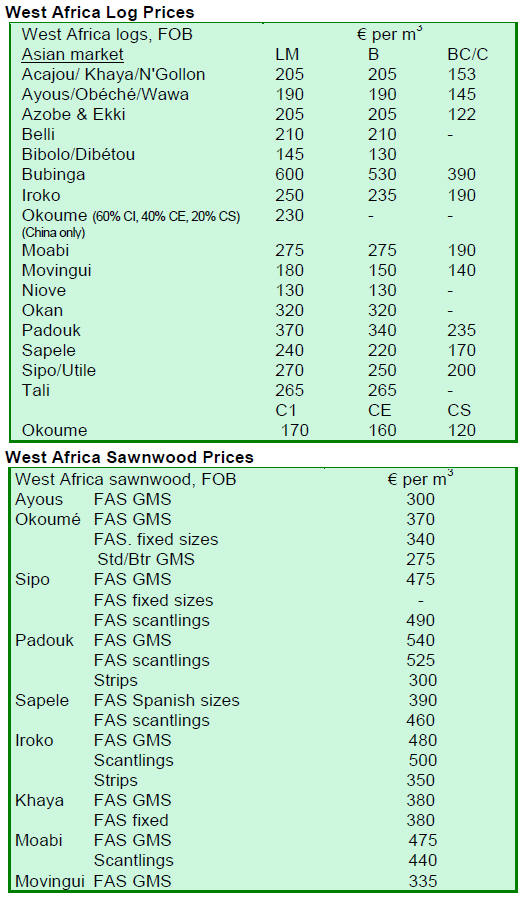
2. GHANA
Second quarter wood product contracts fell 10%
Permits for a total contract volume of 105,926 cu.m of
wood products were approved and processed by the TIDD
in Ghana during the second quarter of 2010, down 10.2%
compared to the first quarter of 2010. As in the first
quarter of 2010, there were no recorded applications for
furniture parts exports in the period under review.
Analysts say this was because of the fact that the main
furniture export company, Scanstyle Mim Limited, has
been concentrating on the domestic market.
Export levels of all major wood products decreased in
volume during the second quarter, except sawnwood and
rotary veneer which picked up by 5.5% and 99%
respectively in comparison to the previous quarter.
Exports of Plywood, poles/billets/logs, sliced veneer and
processed lumber/mouldings fell by 16%, 39%, 44% and
45% respectively compared to the first quarter of 2010.
Sawnwood continued to be the leading export product
accounting for 44% of the total export volume in the
second quarter of 2010.
The regional offices in Kumasi, Accra and Sunyani
accounted for 40%, 1.6% and 12% respectively of the total
export permits issued during the second quarter.
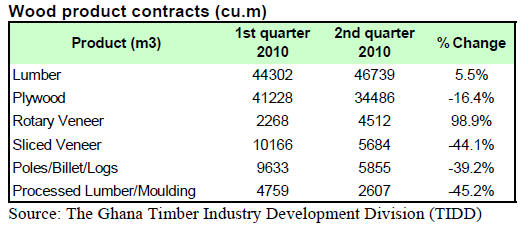
Sales to the Middle East, China and North African countries improve
The falling Euro exchange rate against the US dollar
during the second quarter of 2010 boosted timber exports
from Ghana to the Middle East, China and North African
countries. Ghana¡¯s timber exports are priced in Euro while
contracts made with the aforementioned countries are
quoted in US dollars.
The medium to heavy density species including dahoma,
danta, edinam and denya have been difficult to sell in
European markets, however, markets in the Middle East,
China and North African countries have shown increased
interest in these species.
Due to the booming plywood market in the West African
region, more and more processing mills in Ghana focused
on production of plywood instead of sliced and rotary
veneer for export. As a result, production of veneer for
export has been low since 2009, however, the second
quarter contracts showed improved sales for rotary veneer.
Generally, the contract prices met the Guiding Selling
Prices (GSP) set by the TIDD. The average market prices
for BB/CC quality plywood in the West African region
were 5% to 10% higher than the GSP in the second quarter
of 2010. Prices of mahogany sawnwood for the US market
improved significantly from a price average of US$798
per cu.m in the first quarter to US$830 per cu.m in the
second quarter of 2010.
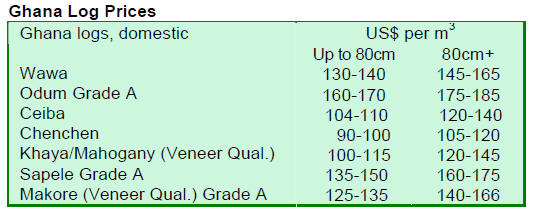

3.
MALAYSIA
Concerns over expansion of the Red List
A recently published study by the International Union for
Conservation of Nature (IUCN) reports that over one-fifth
of the world's plants are under threat of extinction. The
IUCN study suggests that three species; keruing, meranti
and kapur from three different genera Dipterocarpus,
Shorea and Dryobalanops may also be threatened. The
species are not on the IUCN Red List yet as they need to
undergo a lengthy verification process. For more
information: http://www.iucnredlist.org/news/srli-plantspress-
release
The Sarawak Timber Association (STA) stated that
inclusion of these three major commercial tree species into
the IUCN Red List of Threatened Species would severely
impact Sarawak¡¯s timber trade. These three species
account for up to 62% of total log and 24% of sawnwood
exports from Sarawak respectively. In the period from
January to August this year, Sarawak exported 2.71
million cu.m of logs worth RM1.32 billion, compared to
3.78 million cu.m and RM1.79 billion for the entire 2009.
Web based marketing tools for furniture markets
Prices of Malaysian wood and timber products continue to
climb as the US dollar depreciates against the Malaysian
Ringgit. The situation has been beneficial for Malaysian
importers of veneers and other raw materials for the
domestic furniture industry, but at the same time,
Malaysian furniture exporters are facing difficulties in the
international market.
As a result of the appreciating Ringgit coupled with ocean
freight rate increases, exporters of Malaysian furniture are
facing stiff competition, not only from Chinese furniture
manufacturers but also from US based furniture
manufacturers. Some furniture manufacturers in Malaysia
say that their advantage of low-cost manufacturing has
been lost due to the lowest Ringgit to US dollar exchange
rate in 13 years.
In addition, the Malaysian Ringgit has also strengthened
against the Euro having the effect of making Malaysian
furniture exports more expensive in the US market
compared to the exports from Europe.
American department stores such as Macy¡¯s, Sears and
Wal-Mart are collaborating with some US based
manufacturers to market both home and office furniture
through the internet lowering the marketing and retailing
costs. This is an advantage that most Malaysian furniture
manufacturers have been unable to tap.
However, Malaysian owned ¡°Laura Ashley¡± is the
exception. The furniture manufacturer operates in 225
stores in the UK and in 233 franchises worldwide.
Improvements made in web marketing boosted company¡¯s
sales through the internet by 63%. Currently, e-market
sales comprise 12% of the company¡¯s total sales of
furniture and home furnishing.
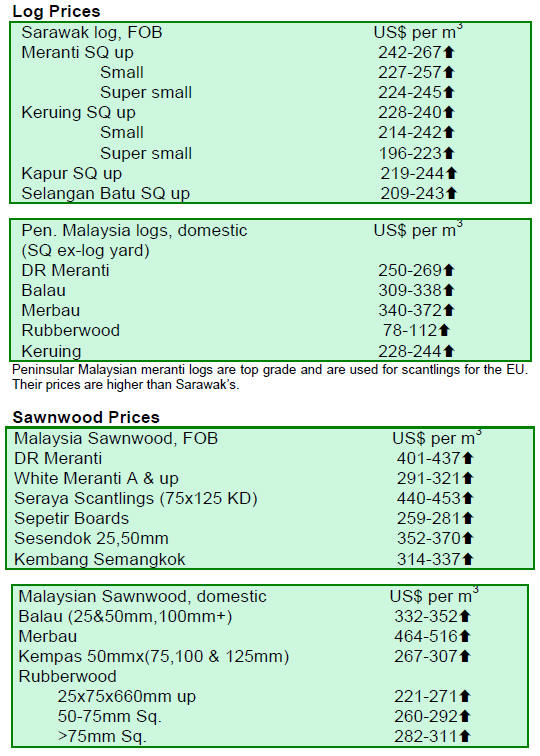
4.
INDONESIA
Indonesia tightens controls to identify
illegally harvested timber
At the beginning of the September, the Indonesian
government strengthened measures to ensure only timber
and timber products with proper documentation proving
legality are exported. Any timber or timber products not
supported by appropriate documentation are immediately
considered as illegally harvested.
Indonesia will apply a system called the Timber Legality
Verification System (SVLK) to track and monitor
industrial forest concessions (HTI), production forest
concessions (HPH) and community plantation forests
(HTR).
The system is said to satisfy European Union legislation
designed to remove illegal wood from European trade.
According to the EU requirements, timber tracking and
due diligence systems are due to be fully effective by 2013.
The Indonesian government commented that they are
committed to the Voluntary Partnership Agreement (VPA)
to be signed with the EU. A technical meeting, planned to
take place by the end of 2010, is to address outstanding
issues before the final agreement is signed. The annexes to
the VPA are expected to be completed by the end of
October 2010.
The VPA requires a specific agency to oversee approval of
licences to export any timber and timber products.
Presently, five institutions including PT Sucofindo, PT
Mutuagung Lestari, PT Mutu Hijau Indonesia, PT TUV
International Indonesia and the Forest Industry
Revitalization Board (BRIK) have been appointed to
verify the legality of timber products for export.
Japan seeks alternatives to overcome rising raw material costs
The Japanese government is considering further
collaboration with the Indonesian Institute of Science
(LIPI) in the area of timber processing. The collaboration
is meant to address the issue of rising raw material prices.
Indonesia is the largest exporter of plywood to the
Japanese market. Japan also imports hardwood roundwood
from other countries which is processed by its downstream
processing industry. Japan has vast domestic forest
resources which it is planning to exploit by legislating for
domestic wood use in the country.
Appreciation of Rupiah eases
Prices of Indonesian timber products remained steady and
largely unchanged as the Indonesian Rupiah depreciated
against the US dollar. Indonesian timber product exporters
earlier expressed their concerns over the continuous
apperception of the Indonesian currency against the US
dollar.
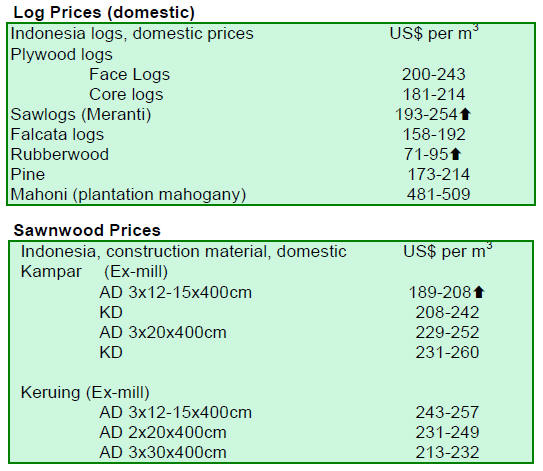
5.
MYANMAR
Domestic
consumption and exports to ASEAN grow
After the economic crisis in 2008/09, timber exports from
Myanmar shifted to some other ASEAN countries and the
Middle East, as the EU countries reduced imports by about
80% compared to the pre-crisis level. U Nay Tun Min,
secretary general of the Timber Merchant Association
(TMA), said this was mainly because buyers from the EU
found their buying power curtailed, while demand from
ASEAN countries like Thailand, Singapore, Vietnam and
Malaysia was strong. However, according to analysts, the
Indian market remains the major export destination for
Myanmar timber with about 70% to 80% share of the total
exports.
Domestic timber demand for construction and furniture
manufacturing has been increasing during the past few
years. Analysts say that the domestic timber processing
industry, however, is suffering from raw material
shortages and thus log exports need to be cut by 50%.
Domestic demand for timber increased sharply after
Cyclone Nargis hit Myanmar in 2008, and the domestic
timber industry provided low cost materials for the
housing sector and to build fishing boats.
Asian Free Trade Agreements facilitating exports
The ASEAN market is becoming more and more
important for Myanmar timber exports after the
establishment of the ASEAN Free Trade Area (AFTA).
Brunei, Indonesia, Malaysia, Philippines, Singapore and
Thailand reduced import tariffs on all products to 0-5% in
January 2010 to comply with the AFTA agreement.
Countries including Cambodia, Laos, Myanmar and
Vietnam are due, by 2015 to reduce the tariff levels to 0-
5%. At present, all wood and timber product exports from
Myanmar enjoy zero export duties.
In addition, the Generalized System of Preferences (GSP),
a programme effective in Japan and Republic of Korea,
provides zero tariff treatment for some imports from
developing countries including value-added timber
products from Myanmar.
The recent agreement with China, the China-ASEAN Free
Trade Area effective from January 2010, has also proven
to be effective in improving Myanmar timber exports to
China.
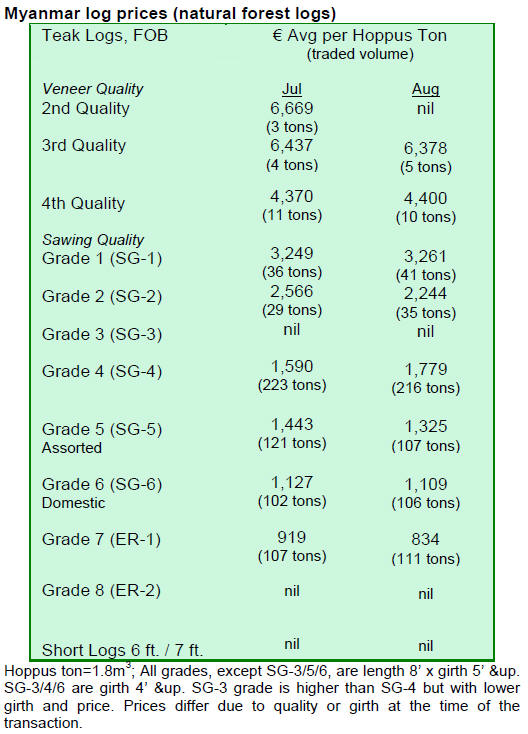
6. INDIA
GDP growth sustained
In the second quarter of 2010, India¡¯s GDP continued to
grow, posting the highest growth rate in 30 months.
Between April ¨C June 2010 GDP surged 8.8% compared
to the same period in 2009. Growth in rural India was
2.8% in the second quarter of 2010 against 1.9% last year.
Buoyant economic activity generated more jobs in the
country during the second quarter of 2010 and GDP is
expected to continue growth towards the target level of
10%.
Exports in August were US$16.6 billion, up 23%
compared to August 2009. At this pace of growth, India is
going to meet the export target of US$200 billion set for
2010. August imports in India grew 32% to US$29.7
billion compared to last year.
Growing interest in planting of non-timber species
The monsoon season has been favourable for the tree
planting in India and as a result, over 1 billion trees have
been planted by NGOs so far. Planted species include
bamboo providing raw material for pulp and paper
industry and also for handicraft manufacturing enhancing
the livelihood of the rural population in forest areas. Other
planted tree species for non-timber production include
mangifera, tamarind, Melia azhadirachta, Melia dubia,
Eugenia and Mimusops diospyros.
The trend of planting non-timber species is well supported
with public participation, for example in Ahmedabad
municipality 919,770 trees were planted around the city
area in one day.
Auction sales in Government Forest depots
At recent log auction sales in Central Indian Government
Forest depots, approximately 19,000 cu.m of teak, 8,600
cu.m of salwood and 7,800 cu.m of mixed hardwood logs
were sold. Demand for domestic teak is improving as
Myanmar teak log imports fall short of demand. However,
due to the monsoon and a quiet period in housing activity,
prices were somewhat lower at Rs.700 for salwood and
Rs.550-600 for mixed hardwoods. The average teak log
prices were as follows:
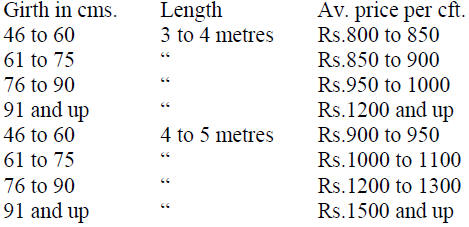
Imported timber and plywood market
CNF timber prices have been increasing due to the
significant rise in ocean freight costs. Especially container
freight rates have surged while break bulk rates are more
flat.
Prices for domestically manufactured marine plywood
have recently been revised due to the higher costs of
labour, chemicals, phenolic resins and timber this is
driving wholesalers to source their plywood from
overseas.
Prices of other grades of locally manufactured plywood
have remained steady, however, analysts expect some
price revisions to come soon.
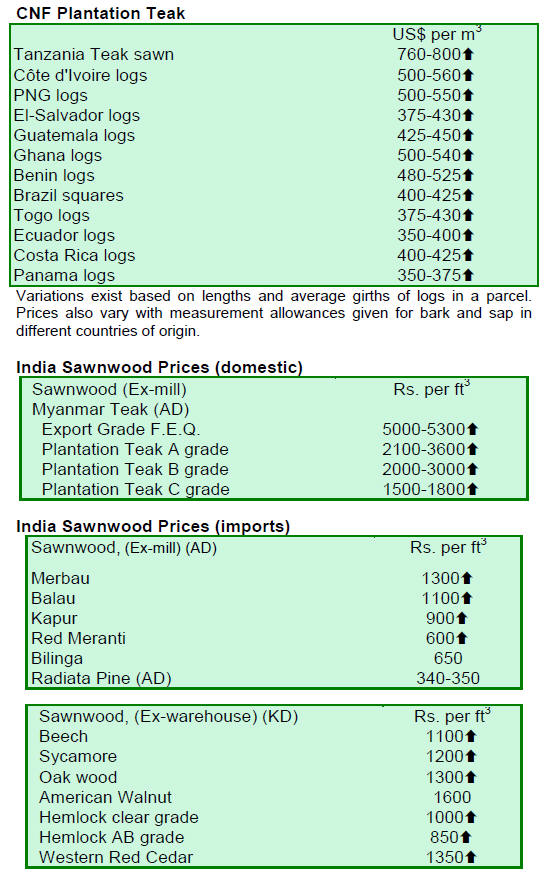
7. BRAZIL
August timber exports
In August 2010, exports of timber products (except pulp
and paper) increased by 22% from US$179 million in
August 2009 to US$217 million.
However, exports of tropical sawnwood decreased in
terms of both volume and value, from 48,400 cu.m in
August 2009 to 42,300 cu.m in August 2010 and from
US$21.3 million to US$19.9 million, representing 12.6%
decline in volume and 6.6% in value.
The recent declines in exports of tropical plywood appear
to have bottomed out as exports increased from 8,800
cu.m in August 2009 to 9,800 cu.m in August 2010, up
11.4%. In value terms, the increase was 10.2%, from
US$4.9 million to US$5.4 million.
Pine sawnwood exports surged 83% in August 2010
compared to the August 2009, from US$7.8 million to
US$14.3 million. In terms of volume, exports rose 47.8%
from 41,800 cu.m to 61,800 cu.m over the period.
The value of pine plywood exports jumped 80% in August
2010 compared to the level in August 2009, from US$18
million to US$32 million. Export volumes grew by 31.4%
during the period, from 66,800 cu.m to 87,800 cu.m.
For wooden furniture, the value of exports rose slightly by
1.3% compared to the level in August 2009 to US$48.1
million in August 2010.
Slight increase in timber prices
The average price of timber products in Brazil increased
slightly from the last fortnight period. The prices in the US
dollars increased 0.46% due to a slight appreciation of
Brazilian currency against the US dollar.
Inflation eases
According to the Brazilian Institute of Geography and
Statistics (IBGE), the Consumer Price Index (IPCA) of
August 2010 showed only a slight increase (0.01%) from
July and a 0.04% increase compared to the same month
last year. The IPCA is the official index used by the
Central Bank to monitor inflation and keep it within the
targeted rate of 4.5% with a tolerance of two percentage
points for 2010. The accumulated IPCA for the first eight
months of the year was 3.2%.
The Copom (Economic Policy Committee) kept the prime
interest rate (Selic) at 10.75% per year in August. The
prime interest rate has been lifted three times this year.
In August 2010, the Brazilian currency slightly
appreciated against the US dollar compared to previous
month, the average exchange rate now being at
BRL1.76/US$.
Forest management more profitable than cattle grazing and agriculture
A Study conducted by the Federal Rural University of
Amazonia (UFRA) for the Par¨¢ State Forest Development
Institute (IDEFLOR) shows that forest management is
more profitable than cattle grazing and agriculture in the
Amazon if cattle farmers and agriculturalists comply fully
with the existing environmental and labour laws.
According to the UFRA, each hectare of Amazon
rainforest can generate BRL22.00 from forest management
per year, compared to BRL6.00 from cattle grazing and
BRL14.00 from agriculture. The comparison considered
the costs of complying with environmental and labour
laws. However, without complying with the legislation,
cattle grazing would be more profitable than forest
management.
The study was carried out to offer guidance for forest
concessionaires in Par¨¢ state forests. The local roundwood
timber market was used as a reference to calculate the
value of standing stock to be managed. The average price
of standing timber was estimated at BRL27.20 per cu.m.
Major challenges of timber industry in Par¨¢
The Par¨¢ Timber Exporters Association (AIMEX) recently
made an assessment of the timber sector in Par¨¢ over the
last four years. The assessment was done in advance of the
next governor¡¯s election taking place in October 2010.
AIMEX presented the following main problems faced by
the sector to Par¨¢ state governor candidates:
- Inefficient administration and excessive bureaucracy
of the State Secretary of the Environment (SEMA);
- Lack of efficient licensing of timber-related activities;
- Lack of standardisation of inspection procedures by
IBAMA (Brazilian Institute for Environment and
Renewable Natural Resources);
- Slow adoption of state forest concessions system.
AIMEX acknowledges that the current government had
successes and has shortcomings. The forestry sector¡¯s
main challenge in the coming years is to recover from the
international financial crisis. AIMEX suggested the
following measures to be implemented:
- Establishment of the Forest Management Support
Programme (PAMFLOR) to bring efficiency and
transparency to the forest licensing system;
- Implementation of the Forest Harvest Plan;
- Meeting the goal of 6.5 million cu.m of timber
production in 2010;
- Establishment of standards for industrial inspection
together with IBAMA;
- Building a policy for the forest industry sector with a
specific tax regime to increase timber industry¡¯s
competitiveness;
- Enabling adequate credit lines for the sector;
- Attaching the forestry sector to the major strategy for
economic development.
Brazilian furniture sector imports certified wood from US
Some Brazilian furniture companies have been replacing
tropical veneers and timber with imported certified wood
from the US. Imported species including walnut, ash, oak,
maple, tulip tree have been used by some Brazilian
furniture manufacturers especially when the final product
is exported to the international markets where the use of
certified timber is necessary.
Ready access to certified timber is one of the reasons
Brazilian furniture makers are beginning to import wood
from the US. In addition, the US timber and veneer supply
is constant around the year while in Brazil; the rain season
interrupts or reduces timber supply for furniture
manufacturers.
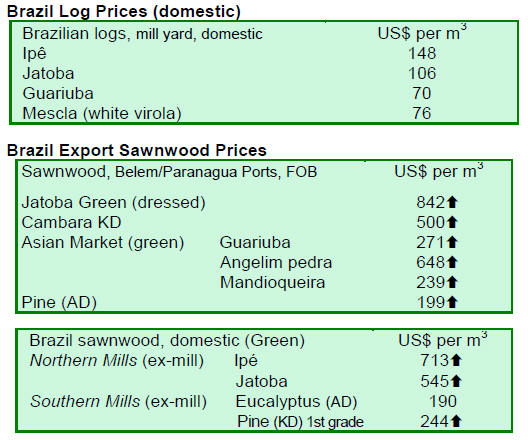
8.
PERU
Sustainable harvest plan for cedar in Peruvian Amazon
In the Peruvian Amazon there are approximately 300,000
cedar trees (Cedrela odorata), which could be exploited
commercially, according to an assessment prepared by the
National Agriculture University of La Molina for the
Ministry of Agriculture and the Environment. According
to the assessment, about 3,000 cedar tree could be
harvested sustainably per year in the Peruvian Amazon.
The assessment complements an earlier study "Evaluation
of commercial stocks and strategy for the sustainable
management of mahogany" by introducing fixed harvest
quota also for cedar. The study also proposes establishing
wood traceability systems, in order to monitor species that
are being harvested and processed for further marketing.
New forestry law to be approved later this year
Wilfredo Panduro, head of the Regional Forest Resource
Management Wildlife Regional Government of Loreto
(formerly INRENA), stated that the draft Forestry Law
was passed back to the Committee preparing the proposal
after comments made in the Congress. Recently, the
committee has been working on collecting more
information and details from the regions to be added to the
next draft.
Environment Minister Antonio Brack said that the new
Forestry and Wildlife law is due to be approved by
Congress in December this year. U.S. representatives have
acknowledged that the Forestry bill in Peru is progressing
well in compliance with the Free Trade Agreement (FTA)
being prepared between the countries. The FTA is almost
completed and the new Forestry and Wildlife law is
needed to finalise the conditions of the agreement. The
rights of indigenous people are still the issue clouding the
bill and its approval in the Congress.
Forest concessions under investigation
Out of the 240 forest concessions in Peru (including
timber, reforestation and ecotourism), between 80 and 100
are under an investigation due to suspected violation of
some regulations, said Omar Guerrero, the deputy director
of Supervision Office of Wood Forest Concessions
(OSINFOR). The infractions that have been found so far
range from bad timber stocking to missing licences or
contracts.
Free Trade Agreement between Peru and Republic of Korea
Peru and Republic of Korea have concluded a Free Trade
Agreement (FTA) which is expected to come into effect in
January 2011.
The total trade between these two countries has been
growing over the past few years totalling US$1.6 billion in
2009. The agreed FTA is said to be a comprehensive pact
involving goods, services and investment opportunities
that will be mutually beneficial.
As a result of the FTA, wood and timber product exports
from Peru to Republic of Korea are anticipated to grow
30%, according to Eric Fischer, chairman of the wood
committee of Peru's Exporters Association.
¡°Korea is a highly industrialised country in this field and
its forest sector provides a wide variety of wood products
that are used for various applications in the construction
sector¡±, Fischer added.

9. GUYANA
Log prices down ¨C sawnwood up
For the period under review, greenheart log prices
remained unchanged while purpleheart and mora log
prices were down.
For sawnwood, undressed greenheart (select) prices
jumped from US$785 per cu.m to US$933 per cu.m over
the period under review. However, the exported volumes
were small.
Similarly, undressed purpleheart (select) gained from
US$750 per cu.m to US$1000 per cu.m while mora
sawnwood prices were steady. Dressed greenheart and
purpleheart both reached higher price averages at US$975
per cu.m and US$912 per cu.m respectively.
During the period under review, baromalli plywood prices
were steady for BB/CC and down for utility category.
Guyana¡¯s washiba (ipe) continues to be in demand
attracting a price average of US$1,600 per cu.m for this
fortnight period.
Roundwood and splitwood contributed to the total export
earnings with favourable average prices the major
destination being the Caribbean market.
For the period under review, exports of value-added
products gained. The major product categories were doors
and windows made from amarante/purpleheart. Also,
NTFP¡¯s and mouldings contributed to the total export
earnings.
Guyana log export policy
Guyana Log Export Policy having a specific focus on
enhancing domestic value-added forest product production
and utilisation of lesser known species came into effect in
January 2009. The policy introduces higher export
commission rates on key log species used for value-added
production in Guyana. Before the imposition of higher
export commission rates, the rate was 2% on all logs. The
current regulation recognises three groups with different
treatments applied since January 2009.
The first group of species were imposed with a 7% export
commission rate effective from January 2009, 10% from
January 2010, and subjected to 12% from January 2011 up
to December 2011. This group includes the following log
species: purpleheart, red cedar, letterwood, bulletwood,
cow wood, tatabu, kabukalli, shibadan, tauroniro, washiba,
hububalli, tonka bean, darina, greenheart, and brown
silverballi.
The second group of species were imposed with a 7%
export commission rate from January 2009 and 10% from
January 2010 up to December 2011. The group includes:
itikiboroballi, determa, wamara, hakia, mora, dukali, keriti
silverballi, wallaba, fukadi, and futui.
The third group exposed to the higher export commission
rates include squares 20.3 cm X 20.3 cm and greater (or 8¡±
X 8¡± and greater). This applies to the following species:
purpleheart, red cedar, letterwood, kabukalli, shibadan,
washiba, hububalli and tonka bean.
According to interim reports, the implementation of
Guyana log export policy has proved to be so far
successful. The main value-added timber species showed
a 40% decrease in log export volume in 2009 and a 25%
decrease in the first half of 2010 compared to the same
period in 2009. Among the main species that have shown
significant decline in log exports are greenheart,
purpleheart, kabukalli and washiba. However, production
volumes of these logs have been maintained implying
higher domestic processing.
Exports of value-added forest products, especially dressed
sawnwood for construction, have increased for washiba,
kabukalli and shibadan as a result of the policy
implementation. The Guyana Forestry Commission (GFC)
has been working to encourage the forest sector to take
steps to further develop timber processing. The GFC
expects that two currently implemented ITTO projects on
Kiln Drying and Forest Industry Development will boost
this effort.
According to the GFC, a comprehensive assessment and
recommendations on the current log export policy will be
published in 2011. In this review, performance of the
current policy, other international examples, and plans for
Guyana¡¯s forest sector will be taken under consideration.
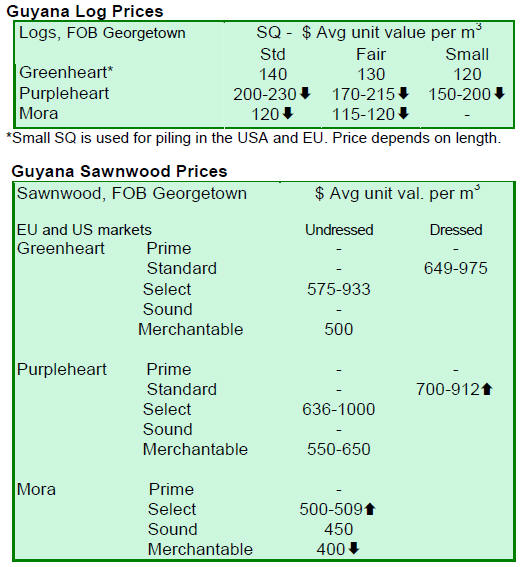
Related News:
|